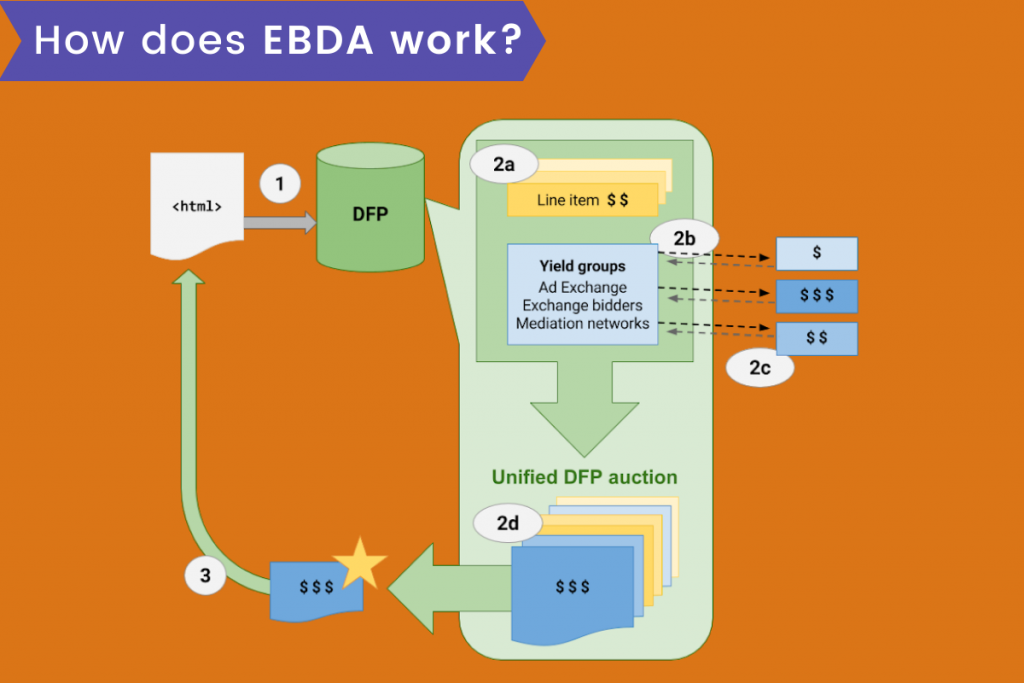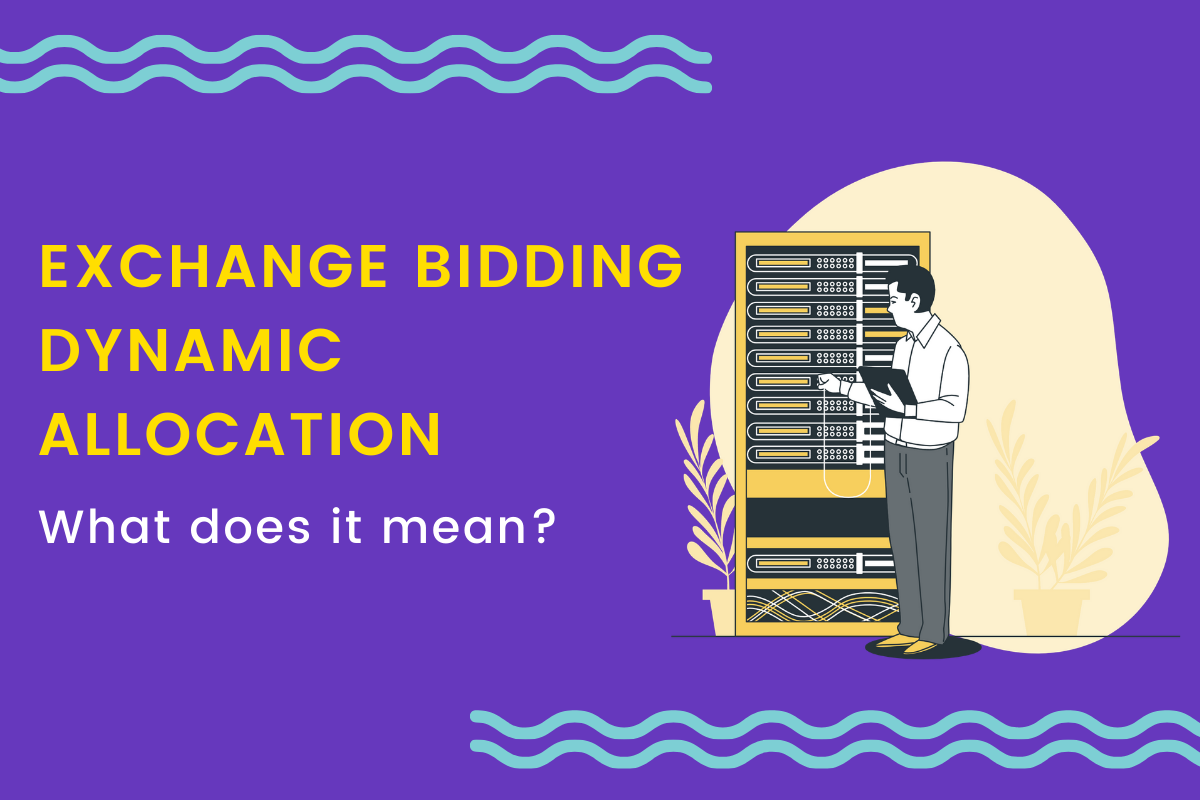Google’s Exchange Bidding Dynamic Allocation (EBDA) also known as Open Bidding is Google’s alternative to Header Bidding. This is an important term for publishers, however many of them are still unaware of the importance and mechanism of Exchange Bidding Dynamic Allocation. In this article, we will understand how EBDA works and its importance for publishers.
Let us give you a brief history of EBDA’s creation. Google’s Ad Exchange (ADX) performed really well with considerable advantages over other competing ad exchanges and supply-side platforms. ADX could run for premium inventory as it could compete with the publisher’s direct sales team before any other platform had access.
Going further, the other platforms needed a fairer model that would provide an equal chance of participation. This led to the creation of header bidding that allowed multiple ad exchanges to participate in a single auction simultaneously. The introduction of header bidding resulted in healthy market competition among platforms for better revenue generation
What is Exchange Bidding Dynamic Allocation?
In its support page, Google defines EBDA as “Exchange Bidding Dynamic Allocation (EBDA) lets the DFP ad server communicate directly with third-party ad exchanges in a server-to-server connection, rather than communicating through custom header bidding code implemented in a publisher’s mobile app or webpage”. By partnering with various exchanges, Google has made services more accessible for publishers via Doubleclick. EBDA became officially available in April 2018.
How does Exchange Bidding Dynamic Allocation work?

Exchange Bidding Dynamic Allocation works in a way that reduces the complexity without affecting the user experience. Let us take a look at how the exchange bidding process works as shown in the figure below:
Triggering Ad Request: Whenever a visitor opens a webpage, the ad request gets triggered. Further, a request is directed to the Ad Manager using Google Mobile Ads SDK, Google Publishing Tags, or the IMA SDK. The important details like the user details, device and targeting are sent along with this request.
Determining the best yield from the Unified Auction: The Ad Manager determines which ads can be the best fit for the available ad space. The parameters included in choosing the best-fit ad are shape, traffic, size and format of the ad. Further, the highest and the most eligible bid is picked and returned to the ad manager.
Winner’s ad is displayed on the publisher’s ad space: At the final step, the Ad Manager returns the request to the page and the winner’s ad is displayed on the publisher’s ad space.
- The entire process reduces the usual time taken to complete an auction for the ad, hence making it beneficial as well as convenient.
- The winning ads with the highest bid are allocated dynamically in real-time by Google which makes it an advanced ad-tech.
Getting onboard with Exchange Bidding
The first and foremost requirement to get started with Exchange Bidding is to have a network that is Exchange bidding compliant.
A publisher can get started immediately if their ad network is one of Google’s public exchange partners.
A Google Ad Manager is also needed to enable exchange bidding for publishers.
Finally, the publishers will need a company on which the demand partners can place their bids. With this, the publishers can watch easily keep track of the bids, yield and revenue generated from the auction.
Header Bidding vs Open Bidding
The purpose of Open bidding/ Exchange bidding and Header bidding is similar- Putting ads in front of the correct set of audience to optimize the publisher’s inventory.
The Header bidding was designed to resolve the issues that occurred due to the waterfall setup. With the help of header bidding, publishers can open their inventories for multiple demand partners before taking them to the ad server. This solves the issue of unsold inventory created and left behind.
On the other hand, with Open Bidding, the publishers can enjoy a transparent auction with minimum complexity. Open bidding runs on the server-side instead of the visitor’s browser which reduces the complexity and page latency. It offers unified reporting and billing management with single time payment for your revenue earned.
However, in the end, it is the publisher’s choice to focus on the pros and cons of both Header bidding and Open bidding and pick one that fits the best.
Readwhere Unity: Recommended Alternative for EBDA
It is a single unified platform competing with prebid and EBDA. In RW Unity, Amazon Unified Auction Marketplace along with Prebid is involved. In this process, the server-side bidders come to Amazon UAM and client-side demand partners come to the Prebid and the bids are compared. The winning bid is selected from both and sent to the Google Ad Manager with four line items running. The top two line item viz. ‘Price Priority Line Item’ calls for the winning bid from Amazon UAM which is further compared to the winning bid submitted by Prebid. These two are further compared to the third section i.e EBDA where demand partners are bidding for the Dynamic Allocation space.
We can see that three different layers of the auction are taking place for a single inventory. The best winning bid from all the three is selected and gets the ad space. However, there is one more layer which includes a guaranteed deal. If the winning bids aren’t higher than the guaranteed deal, they will not be displayed. Along with this, if it is a sponsorship line item, it gets higher priority as compared to the winning bid and finally, the ad is served.
So what is the advantage of RW Unity?
The entire revenue for a publisher is not just dependent on Google.
62% revenue from Google ADX.
EBDA contributes around 18%
Prebid Partner contributes 20%
This created better competition and more demand.
Here are some more perks for RW Unity:
- Transparent & tech agnostic
- Lean and Fast
- Timeout Management
- Health Checking
- Tag Regeneration
- Unified Bidding
- Simple Reporting
Click here to learn more about RW Unity and the best practices for AD management in our webinar.
If you need any more assistance or have any doubts, please mention it in the comments section. We’d love to hear from you.


